C# Edit Excel File
Developers have to be careful when they set out to modify and edit Excel files in C# because it can be easy for one misstep to change the whole document. Being able to rely on simple and efficient lines of code helps reduce the risk of error, and makes it easier for us to edit or delete Excel files programmatically. Today we'll walk through the steps necessary to edit Excel files in C# correctly and quickly using tested functions.
How to Edit Excel File in C#
- Download the C# Edit Excel Library
- Edit Specific Cell Values
- Edit full row values of an Excel SpreadSheet with a static value
- Edit full columns of Excel SpreadSheet values with a single value
- Edit Full Row with Dynamic Values
- Replace Spreadsheet Values
- Remove Row from Excel WorkSheet
- Remove WorkSheet from Excel File
Step 1
1. C# Edit Excel Files using the IronXL Library
For this tutorial, we'll be using the functions defined by IronXL, a C# Excel library. To use these functions you'll need to first download and install it into your project (free for development).
You can either Download IronXL.zip or read more and install via the NuGet package page.
Once you've installed it, let's get started!
Install-Package IronXL.Excel
Replace x.x.x with the appropriate version number as needed.
How to Tutorial
2. Edit Specific Cell Values
First, we will look at how to edit specific cell values of an Excel SpreadSheet.
For this purpose, we import the Excel SpreadSheet which is to be modified, and then access its WorkSheet. Then we can apply the modifications as shown below.
// Import necessary namespaces
using IronXL;
static void Main(string[] args)
{
// Load the Excel workbook
WorkBook wb = WorkBook.Load("sample.xlsx");
// Access a specific worksheet
WorkSheet ws = wb.GetWorkSheet("Sheet1");
// Access specific cell by identifying its row and column, then modify its value
ws.Rows[3].Columns[1].Value = "New Value";
// Save changes to the workbook
wb.SaveAs("sample.xlsx");
}// Import necessary namespaces
using IronXL;
static void Main(string[] args)
{
// Load the Excel workbook
WorkBook wb = WorkBook.Load("sample.xlsx");
// Access a specific worksheet
WorkSheet ws = wb.GetWorkSheet("Sheet1");
// Access specific cell by identifying its row and column, then modify its value
ws.Rows[3].Columns[1].Value = "New Value";
// Save changes to the workbook
wb.SaveAs("sample.xlsx");
}' Import necessary namespaces
Imports IronXL
Shared Sub Main(ByVal args() As String)
' Load the Excel workbook
Dim wb As WorkBook = WorkBook.Load("sample.xlsx")
' Access a specific worksheet
Dim ws As WorkSheet = wb.GetWorkSheet("Sheet1")
' Access specific cell by identifying its row and column, then modify its value
ws.Rows(3).Columns(1).Value = "New Value"
' Save changes to the workbook
wb.SaveAs("sample.xlsx")
End SubHere are before and after screenshots of Excel SpreadSheet sample.xlsx:
| Before | After |
|---|---|
 |
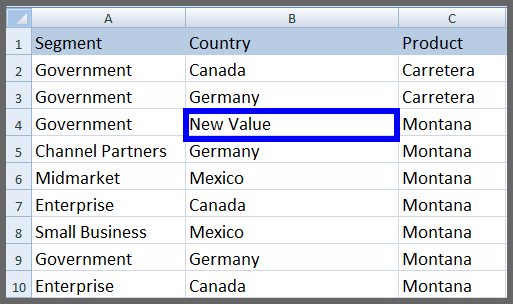 |
We can see how simple it is to modify the Excel SpreadSheet value.
If needed, there is also an alternative way to edit the specific cell value by cell address:
// Alternative way to access specific cell and apply changes
ws["B4"].Value = "New Value";// Alternative way to access specific cell and apply changes
ws["B4"].Value = "New Value";' Alternative way to access specific cell and apply changes
ws("B4").Value = "New Value"3. Edit Full Row Values
It is pretty simple to edit full row values of an Excel SpreadSheet with a static value.
// Import necessary namespaces
using IronXL;
static void Main(string[] args)
{
WorkBook wb = WorkBook.Load("sample.xlsx");
WorkSheet ws = wb.GetWorkSheet("Sheet1");
// Setting a static value for the entire row
ws.Rows[3].Value = "New Value";
wb.SaveAs("sample.xlsx");
}// Import necessary namespaces
using IronXL;
static void Main(string[] args)
{
WorkBook wb = WorkBook.Load("sample.xlsx");
WorkSheet ws = wb.GetWorkSheet("Sheet1");
// Setting a static value for the entire row
ws.Rows[3].Value = "New Value";
wb.SaveAs("sample.xlsx");
}' Import necessary namespaces
Imports IronXL
Shared Sub Main(ByVal args() As String)
Dim wb As WorkBook = WorkBook.Load("sample.xlsx")
Dim ws As WorkSheet = wb.GetWorkSheet("Sheet1")
' Setting a static value for the entire row
ws.Rows(3).Value = "New Value"
wb.SaveAs("sample.xlsx")
End SubSee the screenshots of sample.xlsx below:
| Before | After |
|---|---|
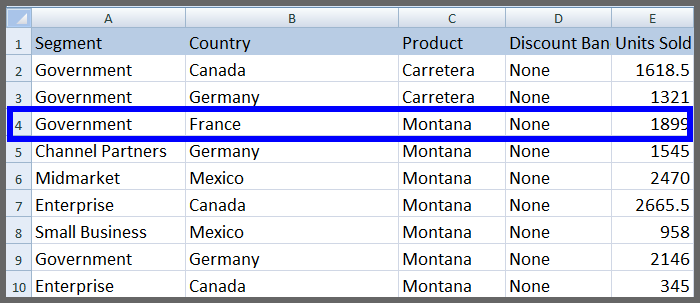 |
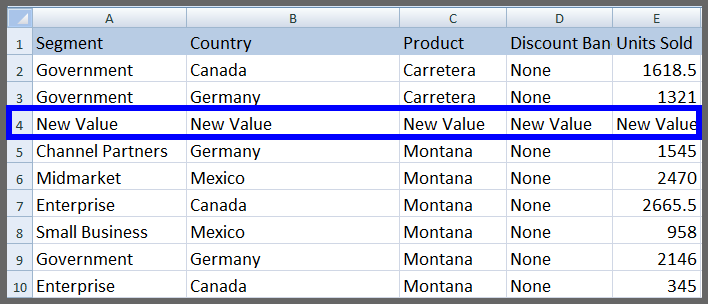 |
For this, we also can edit the value of a specific range of the row, by using range function:
// Editing a specific range of a row
ws["A3:E3"].Value = "New Value";// Editing a specific range of a row
ws["A3:E3"].Value = "New Value";' Editing a specific range of a row
ws("A3:E3").Value = "New Value"4. Edit Full Column Values
In the same way as above, we can easily edit full columns of Excel SpreadSheet values with a single value.
// Import necessary namespaces
using IronXL;
static void Main(string[] args)
{
WorkBook wb = WorkBook.Load("sample.xlsx");
WorkSheet ws = wb.GetWorkSheet("Sheet1");
// Setting a static value for the entire column
ws.Columns[1].Value = "New Value";
wb.SaveAs("sample.xlsx");
}// Import necessary namespaces
using IronXL;
static void Main(string[] args)
{
WorkBook wb = WorkBook.Load("sample.xlsx");
WorkSheet ws = wb.GetWorkSheet("Sheet1");
// Setting a static value for the entire column
ws.Columns[1].Value = "New Value";
wb.SaveAs("sample.xlsx");
}' Import necessary namespaces
Imports IronXL
Shared Sub Main(ByVal args() As String)
Dim wb As WorkBook = WorkBook.Load("sample.xlsx")
Dim ws As WorkSheet = wb.GetWorkSheet("Sheet1")
' Setting a static value for the entire column
ws.Columns(1).Value = "New Value"
wb.SaveAs("sample.xlsx")
End SubWhich will produce our sample.xlsx spreadsheet as such:
| Before | After |
|---|---|
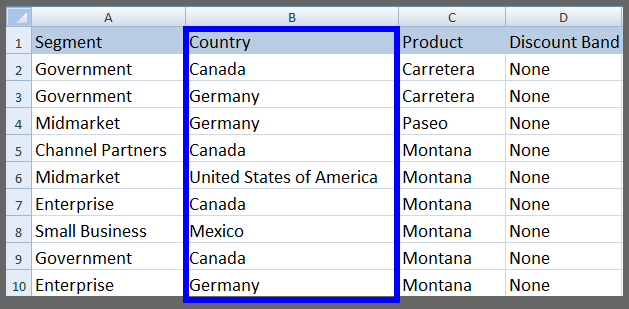 |
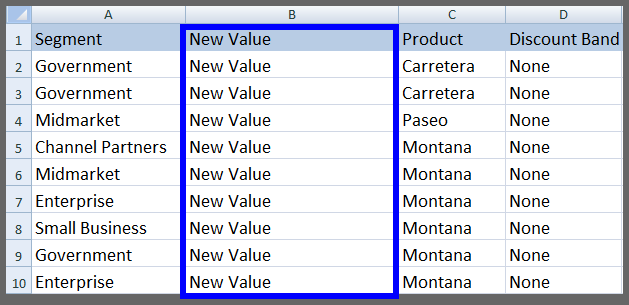 |
5. Edit Full Row with Dynamic Values
Using IronXL, it is also possible to edit specific rows with dynamic values. This means we can edit a full row by assigning dynamic values for each cell. Let's see the example:
// Import necessary namespaces
using IronXL;
static void Main(string[] args)
{
WorkBook wb = WorkBook.Load("sample.xlsx");
WorkSheet ws = wb.GetWorkSheet("Sheet1");
for (int i = 0; i < ws.Columns.Count(); i++)
{
// Assign dynamic values to each cell in the row
ws.Rows[3].Columns[i].Value = "New Value " + i.ToString();
}
wb.SaveAs("sample.xlsx");
}// Import necessary namespaces
using IronXL;
static void Main(string[] args)
{
WorkBook wb = WorkBook.Load("sample.xlsx");
WorkSheet ws = wb.GetWorkSheet("Sheet1");
for (int i = 0; i < ws.Columns.Count(); i++)
{
// Assign dynamic values to each cell in the row
ws.Rows[3].Columns[i].Value = "New Value " + i.ToString();
}
wb.SaveAs("sample.xlsx");
}' Import necessary namespaces
Imports IronXL
Shared Sub Main(ByVal args() As String)
Dim wb As WorkBook = WorkBook.Load("sample.xlsx")
Dim ws As WorkSheet = wb.GetWorkSheet("Sheet1")
For i As Integer = 0 To ws.Columns.Count() - 1
' Assign dynamic values to each cell in the row
ws.Rows(3).Columns(i).Value = "New Value " & i.ToString()
Next i
wb.SaveAs("sample.xlsx")
End SubIn the table below, we see the screenshots of Excel SpreadSheet sample.xlsx from this output:
| Before | After |
|---|---|
 |
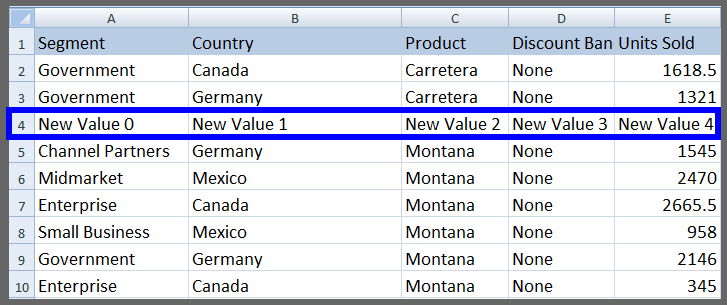 |
6. Edit Full Column with Dynamic Values
It is also simple to edit specific columns with dynamic values.
// Import necessary namespaces
using IronXL;
static void Main(string[] args)
{
WorkBook wb = WorkBook.Load("sample.xlsx");
WorkSheet ws = wb.GetWorkSheet("Sheet1");
for (int i = 0; i < ws.Rows.Count(); i++)
{
// Skip the first row if it's used as a header
if (i == 0)
continue;
// Assign dynamic values to each cell in the column
ws.Rows[i].Columns[1].Value = "New Value " + i.ToString();
}
wb.SaveAs("sample.xlsx");
}// Import necessary namespaces
using IronXL;
static void Main(string[] args)
{
WorkBook wb = WorkBook.Load("sample.xlsx");
WorkSheet ws = wb.GetWorkSheet("Sheet1");
for (int i = 0; i < ws.Rows.Count(); i++)
{
// Skip the first row if it's used as a header
if (i == 0)
continue;
// Assign dynamic values to each cell in the column
ws.Rows[i].Columns[1].Value = "New Value " + i.ToString();
}
wb.SaveAs("sample.xlsx");
}' Import necessary namespaces
Imports IronXL
Shared Sub Main(ByVal args() As String)
Dim wb As WorkBook = WorkBook.Load("sample.xlsx")
Dim ws As WorkSheet = wb.GetWorkSheet("Sheet1")
For i As Integer = 0 To ws.Rows.Count() - 1
' Skip the first row if it's used as a header
If i = 0 Then
Continue For
End If
' Assign dynamic values to each cell in the column
ws.Rows(i).Columns(1).Value = "New Value " & i.ToString()
Next i
wb.SaveAs("sample.xlsx")
End SubWith the table results of sample.xlsx below:
| Before | After |
|---|---|
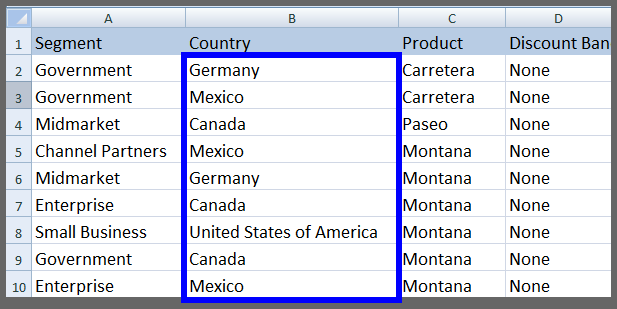 |
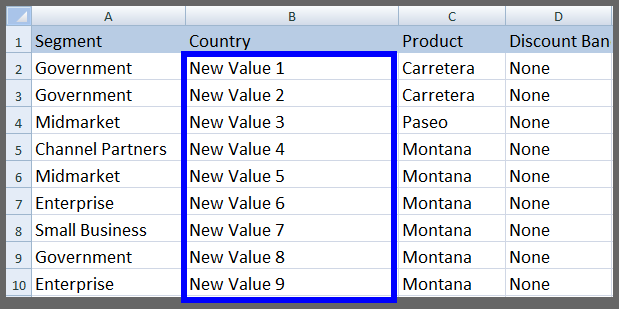 |
7. Replace Spreadsheet Values
If we want to replace any type of value with an updated value in an Excel SpreadSheet, we can use the function named Replace. Using this function, we can replace the data of Excel SpreadSheet in any required situation.
7.1. Replace Specific Value of Complete WorkSheet
To replace a specific value of a complete Excel WorkSheet with an updated value, we just access the WorkSheet ws (same as in the above examples) and apply the Replace function like this.
// Replace a specific value in the entire worksheet
ws.Replace("old value", "new value");// Replace a specific value in the entire worksheet
ws.Replace("old value", "new value");' Replace a specific value in the entire worksheet
ws.Replace("old value", "new value")This function will replace old value with new value in a complete Excel WorkSheet.
Don't forget to save the file after any change, as shown in the examples above.
7.2. Replace the Values of Specific Row
If you only want to make changes to a specific row instead of the whole worksheet, use this code.
// Replace a specific value in a specific row
ws.Rows[2].Replace("old value", "new value");// Replace a specific value in a specific row
ws.Rows[2].Replace("old value", "new value");' Replace a specific value in a specific row
ws.Rows(2).Replace("old value", "new value")The above code will replace old value with new value only in row number 2. The rest of the WorkSheet remains the same.
7.3. Replace the Values of Row Range
We also can replace the values within a specific range as follows:
// Replace specific values in a row range
ws["From Cell Address : To Cell Address"].Replace("old value", "new value");// Replace specific values in a row range
ws["From Cell Address : To Cell Address"].Replace("old value", "new value");' Replace specific values in a row range
ws("From Cell Address : To Cell Address").Replace("old value", "new value")Suppose, if we want to replace an old value with a new value, just in the range from B4 to E4 of row no 4, then we would write it like this:
ws["B4:E4"].Replace("old value", "new value");ws["B4:E4"].Replace("old value", "new value");ws("B4:E4").Replace("old value", "new value")7.4. Replace the Values of Specific Column
We can also replace the values of a specific column, and the rest of the worksheet remains the same.
// Replace specific values in a column
ws.Columns[1].Replace("old value", "new value");// Replace specific values in a column
ws.Columns[1].Replace("old value", "new value");' Replace specific values in a column
ws.Columns(1).Replace("old value", "new value")The above code will replace old value with new value just for column number 1.
7.5. Replace the Values of Column Range
By the following way, we also can use the range function to replace within a range of a specific column.
// Replace specific values in a column range
ws["B5:B10"].Replace("old value", "new value");// Replace specific values in a column range
ws["B5:B10"].Replace("old value", "new value");' Replace specific values in a column range
ws("B5:B10").Replace("old value", "new value")The above code will replace old value with new value just within range from B5 to B10 for column B.
8. Remove Row from Excel WorkSheet
IronXL provides a very simple function to remove a specific row of an Excel WorkSheet. Let's see the example.
// Import necessary namespaces
using IronXL;
static void Main(string[] args)
{
WorkBook wb = WorkBook.Load("sample.xlsx");
WorkSheet ws = wb.GetWorkSheet("Sheet1");
// Remove a specific row
ws.Rows[3].RemoveRow();
wb.SaveAs("sample.xlsx");
}// Import necessary namespaces
using IronXL;
static void Main(string[] args)
{
WorkBook wb = WorkBook.Load("sample.xlsx");
WorkSheet ws = wb.GetWorkSheet("Sheet1");
// Remove a specific row
ws.Rows[3].RemoveRow();
wb.SaveAs("sample.xlsx");
}' Import necessary namespaces
Imports IronXL
Shared Sub Main(ByVal args() As String)
Dim wb As WorkBook = WorkBook.Load("sample.xlsx")
Dim ws As WorkSheet = wb.GetWorkSheet("Sheet1")
' Remove a specific row
ws.Rows(3).RemoveRow()
wb.SaveAs("sample.xlsx")
End SubThe above code will remove row number 3 of sample.xlsx as shown in the following table:
| Before | After |
|---|---|
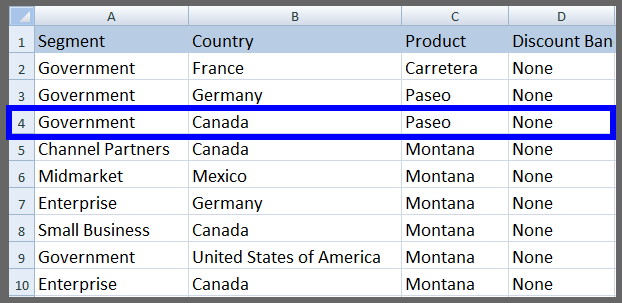 |
 |
9. Remove WorkSheet from Excel File
If we want to remove a complete WorkSheet of an Excel file, we can use the following method:
// Remove a worksheet by its index
wb.RemoveWorkSheet(1); // by sheet indexing// Remove a worksheet by its index
wb.RemoveWorkSheet(1); // by sheet indexing' Remove a worksheet by its index
wb.RemoveWorkSheet(1) ' by sheet indexingwb is the WorkBook, same as in the above examples. If we want to remove a worksheet by name, then:
// Remove a worksheet by its name
wb.RemoveWorkSheet("Sheet1"); //by sheet name// Remove a worksheet by its name
wb.RemoveWorkSheet("Sheet1"); //by sheet name' Remove a worksheet by its name
wb.RemoveWorkSheet("Sheet1") 'by sheet nameIronXL is rich with many more functions by which we can easily perform any type of editing and deletion in Excel SpreadSheets. Please reach out to our dev team if you have any questions for use in your project.
Library Quick Access
IronXL Library Documentation
Explore the full capabilities of IronXL C# Library with various functions for editing, deleting, styling, and perfecting your Excel workbooks.
IronXL Library Documentation
Frequently Asked Questions
How can I edit specific cell values in an Excel file using C#?
To edit specific cell values in an Excel file using C#, you can use the IronXL library. Load the Excel workbook, access the desired worksheet, and modify the cell value using the appropriate row and column indices.
What library is recommended for editing Excel files in C#?
The IronXL library is recommended for editing Excel files in C#. It allows you to perform various operations like modifying cell values, rows, columns, and even removing worksheets without using Interop.
How do I replace spreadsheet values in a C# application?
You can replace spreadsheet values in a C# application using the IronXL library's Replace function. This function allows you to replace specific values in the entire worksheet, a specific row, column, or within a specified range.
How can I remove a worksheet from an Excel file using C#?
To remove a worksheet from an Excel file using C#, you can utilize the IronXL library's RemoveWorkSheet method. You can remove a worksheet either by its index or by its name.
Can I edit full row values with dynamic content using C#?
Yes, you can edit full row values with dynamic content using C#. IronXL allows you to assign dynamic values to each cell in a row by iterating through the columns.
Is it possible to edit entire columns in an Excel file using C#?
Yes, using the IronXL library, you can edit entire columns in an Excel file with a single value. You can set a static value for the entire column or use dynamic values as needed.
How do I remove a specific row from an Excel worksheet in C#?
To remove a specific row from an Excel worksheet in C#, use the IronXL library's RemoveRow method on the desired row.
What are the steps to start editing Excel files in C#?
To start editing Excel files in C#, first download and install the IronXL library. Then, load your Excel workbook, access the worksheet you want to edit, and use the provided functions to modify cells, rows, columns, or worksheets.
Is it suitable for development environments?
Yes, IronXL is suitable for development environments and can be freely used for development purposes. It provides a robust set of functions for editing Excel files programmatically.

















